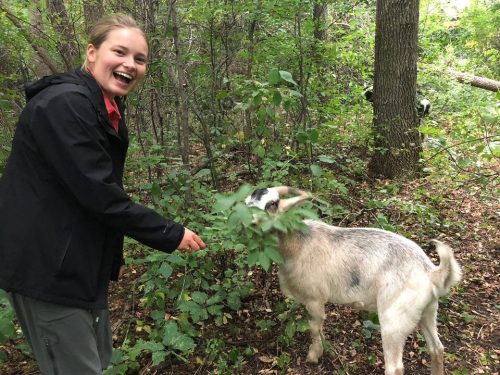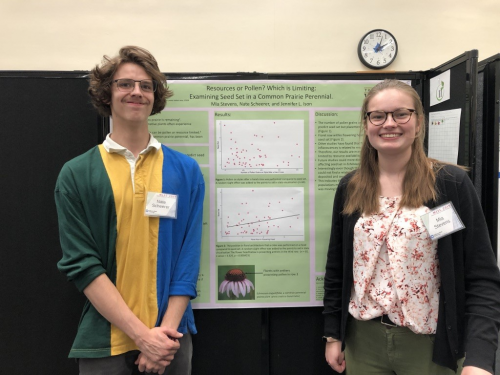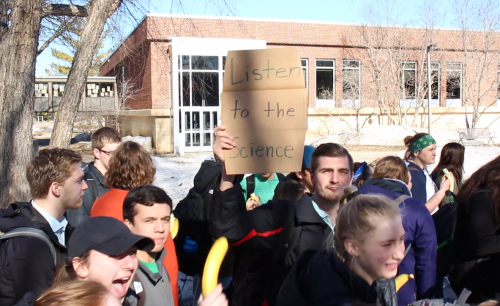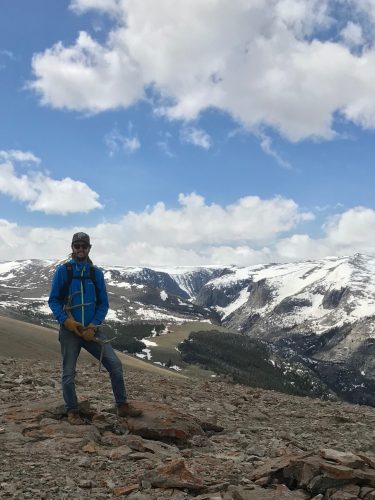|
|
Hey flog! I’m back!
Echinacea Project 2019
Biology, College of Wooster 2020
Research Interests:
In general I am interested in how plants interact with their surroundings, particularly the other plants in the system. I worked with Team Echinacea last year on a project attempting to determine how many pollen grains it takes to set a seed. Turns out it doesn’t matter and on the head a floret is that determines seed set! In the fall/this summer I will be starting my senior thesis/IS (independent study) with a plant called Coral Bean (Erythrina flabelliformis) in Arizona. I will be investigating how mating is affected by the amount of flowers on a plant and geographic/temporal distance between plants.
Personal Interests:
I am now a senior biology major with a minor in environmental studies at the College of Wooster. I am from Buffalo, NY. At school I am former president of knitting club, but recently I have really gotten into embroidery. I also enjoy spending time outside with my dog named Ellie.
 Me last summer feeding one of the goats buckthorn MEEC 2019:
On a different note another student from Wooster (Nate) and I presented at MEEC. We presented a poster on my pollen to seed ratios from my research last summer. As it turns out, pollen is not the limiting resource to determine seed set but instead the location of a floret on the flower head.
 Nate and I at MEEC with our poster. Link to poster:Pollen to Seed Poster
Title: Resources or pollen: examining seed set in a common prairie perennial.
Presented at: MEEC 2019 at Indiana State University in Terre Haute, IN
When: April 27, 2019
Echinacea Project 2019
Biology, The College of Wooster ‘20
Research Interests:
I am interested at investigating how different species of solitary bees impact male fitness in Echinacea. Additionally, I’m interested in the varying impacts climate change is having on different ecosystems and the interactions between organisms within these ecosystems.
Personal Statement:
I am a Biology major and Classical Studies minor from Cincinnati, OH. I will be part of the lab team in Wooster this summer, but will also join the field team in Minnesota for a few weeks during flowering season. In my free time, I love reading, baking, and exploring the outdoors. I also enjoy swimming and spending time with friends and family.

Jennifer L. Ison
Echinacea Project 2019
Assistant Professor of Biology, The College of Wooster (Wooster, Ohio), 2015 -present
Research interests
I’m a plant ecologist who is interested in how plants in human-altered landscapes mate. In particular, I’ve examined how spatial isolation and variation in flowering times limit mating opportunities between plants. Recently, we have examined how visits by different native bee species impact reproduction in insect-pollinated plants. We have found that the specialist-solitary bee, Andrena rudbeckia, is the most efficient Echinacea pollinator, both in terms of pollinating florets (individual flowers) and removing pollen (Page et al. submitted; Zelman 2019 thesis). However, we have also found that Andrena is typically only found in the largest Echinacea populations and is only active during early and peak flowering time (Ison et al. 2018 Oikos).
Last summer we conducted a large field experiment to understand how visits from different native bees contribute to a plant’s male fitness (siring success). For more information about this project please read Mia’s great flog post about the project. This summer Mia, Avery, Miyauna, and Ren are working genotyping the offspring from this study using previously developed genetic tools.
Statement
I’ve collaborated with the Echinacea Project for many years (before there was even a flog!). I started as a Team Member back in 2003 after graduating from St. Olaf College. After a few years, I started my dissertation research on Echinacea. After completing my dissertation, I took a few years off the Echinacea Project to work on a plant that takes 30 days (instead of 7 years) to flower. However, I couldn’t stay away from Echinacea and have been examining Echinacea‘s pollinators since 2013. When I am not watching bees on Echinacea, I enjoy hiking, especially with my very active nearly-four-year-old.
Echinacea Project 2019
Biology Honors, Gustavus Adolphus College ’19
Research Interests
My research interests include everything from community ecology to population and quantitative genetics and physiological ecology. That said, I love linking these different fields to plant conservation. I have found recently that I enjoy reading quantitative and population genetics papers the most that link their work ultimately to community dynamics. I recently completed my senior honors thesis at Gustavus with data from Team Echinacea’s hybrid experimental plot 7, and working with the data made me think of some interesting questions regarding the genetic structure of Echinacea angustifolia within the remnants.
Statement
I am from the wonderful suburb of Bloomington, Minnesota. In my limited free time, I like to spend time with friends, play sports (softball, tennis, etc…), and play board games – especially cribbage. I also really love to be outside and go for walks, hikes, runs, and bike rides. I took a plant systematics course my final semester of college, so I have recently taken to naming every tree that I walk by when I am with friends. My final area of deep interest is competitive Pokémon battling; it really gets me to use my brain in new, creative ways, even if it is a children’s game.
 This is me at school during a march for climate action (I’m the one with the sign)!
Echinacea Project 2018

Assistant Professor of Biology, The College of Wooster (Wooster, Ohio), 2015 -present
Research Interests
Reproduction in flowering plants is particularly vulnerable to fragmentation and the loss of insect pollinators. Typically plants with hermaphroditic flowers have mechanisms that reduce the likelihood of pollination within the same flower and require a vector (i.e., wind or pollinator) for successful sexual reproduction. Native solitary bees are common pollinators for many plants species. However, pollination research has mainly focused on large social bees—bumblebees and the non-native honeybee. In addition, most studies only quantify seed set (i.e., the female fitness of a plant), thus ignoring fitness contributions from siring seeds (i.e., the male fitness of a plant).
This summer we will quantify how four generalist solitary bee taxa contribute to total male fitness in a mate-limited prairie plant, Echinacea angustifolia. We will also compare how each pollinator taxon varies in its relative contribution to a plant’s male and female fitness. To quantify male and female fitness, we will use a combination of a novel manipulative field experiment and previously developed genetic tools. This summer’s research will build on previous pollination research by College of Wooster thesis students. In 2016, we found that Echinacea’s pollinator community changes over the course of the flowering season (see: Ison, JL, LJ. Prescott, SW Nordstrom, A Waananen, and S Wagenius. 2018. Pollinator-mediated mechanisms for increased reproductive success in early flowering plants. Oikos. doi:10.1111/oik.04882)
Statement
Hi floggers! I’ve collaborated with the Echinacea project for many years (before there was even a flog!). I started as a Team Member back in 2003 after graduating from St. Olaf College. After few years, I started my dissertation research on Echinacea. After completing my dissertation, I took a few years off the Echinacea Project to work on a plant that takes 30 days (instead of 7 years) to flower. However, I couldn’t stay away from Echinacea and have been examining Echinacea‘s pollinators since 2013. When I am not watching bees on Echinacea, I enjoy hiking and tennis. I also have a very active nearly-three-year-old who loves being outside.
Echinacea Project 2018
Plant Biology & Conservation, Northwestern University 2017-
Ecology & Evolutionary Biology, University if Kansas 2017
Research Interests
Broadly, I am interested in how landscape dynamics shape bee communities. Did you know that over 80% of bees in the prairie spend part of their life in the ground? We have lots of information about how bees forage and the kinds of pollen they forage for, but know very little about the kinds of conditions suitable for bees to build their nests. My thesis project explores how land use history and soil microhabitat indicators influence nesting densities. This summer I will explore how common land use treatments (remnant prairies, restorations, and old agricultural fields) influence where bees build their nests!
Statement
I am a Master’s student in Plant Biology & Conservation through Northwestern University and the Chicago Botanic Garden. I grew up moving all over the country but went to high school and college in the Kansas City area. I believe passionately in diversity and inclusion and try to do my part to make STEM a more equitable field for people of all backgrounds and identities. I am active on Twitter and Instagram and am learning how to use these platforms for science education and communication. I love to read in my spare time, but I also just enjoy learning/speaking Spanish, listening to good music, smelling candles, and cooking yummy food!
 Some bees posing with me and a microscope!
Echinacea Project 2018
Ecology and Evolutionary Biology, University of Colorado Boulder, 2018 –
Ecology, Evolution, and Behavior, University of Minnesota, 2018
Research Interests
I am broadly interested in the genetics of plant populations as well as investigating how phenotypes are expressed in different environments. I have estimated the heritability of flowering time in Echinacea angustifolia and I would like to evaluate selection on flowering time. I am also interested in learning about patterns of flowering across a fragmented landscape, like the one we study in western MN!
Statement
I am from Alexandria, MN, about 20 minutes east of our study site. This will be my fifth year working on the project! In my free time, I like to do outdoor things, I particularly enjoy fly fishing and hiking. I also enjoy finding and listening to new music. This summer I plan to spend lots of my free time playing with our new puppy!

Echinacea Project 2018
Biology, College of Wooster 2018
Research Interests
I am interested in studying how different species of bees could have different effects on the fitness of flowering plants in the Prairie. More broadly I am interested in learning more about the pollination biology, and the prairie, and how both relater to conservation efforts and agriculture.
Statement
I am from Bennington, Vermont. I’m looking forward to spending some time in Minnesota. I haven’t had much experience studying plants, but I’m excited to learn. In my free time I like to to: play ultimate Frisbee, run, read, watch TV, hike, cross-country ski, etc.

Echinacea Project 2018
Ecology, Evolution, and Behavior, University of Minnesota, 2017-
Biology, St. Olaf College, 2015
Research Interests
I’m interested in how bees move pollen between isolated plant populations and whether this movement maintains connectivity between populations, potentially mitigating the genetic and demographic decline caused by habitat fragmentation and small population sizes. This summer, I’m hoping to understand this better by starting a project to look at pollen movement within and among the remnant populations of Echinacea, and how these movement patterns relate to individuals’ spatial isolation and phenology.
Statement
Hey flog, I’m back! I used to be an intern with Team Echinacea and now I’m a grad student in Ecology, Evolution, and Behavior at the University of Minnesota. In my free time I like to garden, read, bake, cook, swim, run, ski, and fish! I’m very excited to be back in western Minnesota again this summer. I’m especially looking forward to collecting exciting data, learning about the exciting new projects the team is starting, eating watermelon, and writing flog posts! In the future, I hope to understand how habitat fragmentation affects the way bees move pollen around landscapes and win a trollphy at Flekkefest.
 Here’s me with some flowers!
Biology and Environmental Studies, Tufts University 2018
Research Interests
I have been interested in plants since I was old enough to explore the woods in my backyard. Since then, I have done research on plants throughout my college career everywhere from Costa Rica to Iceland and found myself incredibly intrigued by how changing landscapes affect ecosystem dynamics, particularly plant-insect interactions. I have never before been a part of a research project that has been as long-term as the Echinacea Project, nor have I ever been to the long grass prairie, let alone researched it.
Statement
I grew up in Sudbury, Massachusetts about 20 miles west of Boston, and just graduated to Tufts University about a month ago. In my free time, I enjoy running, hiking, reading, or just about any activity that involves being outdoors. I hope in the future to make field biology my career, and am very excited to join Team Echinacea!

|
|











